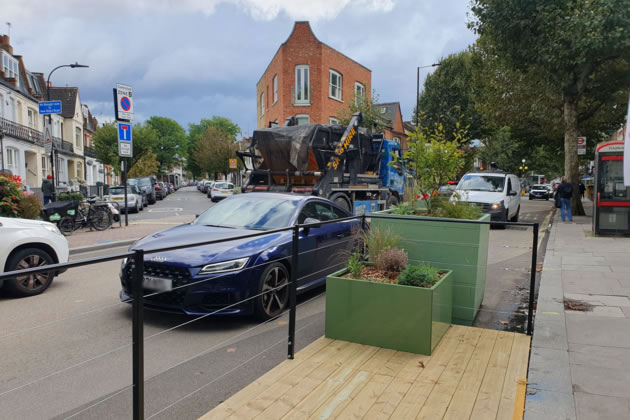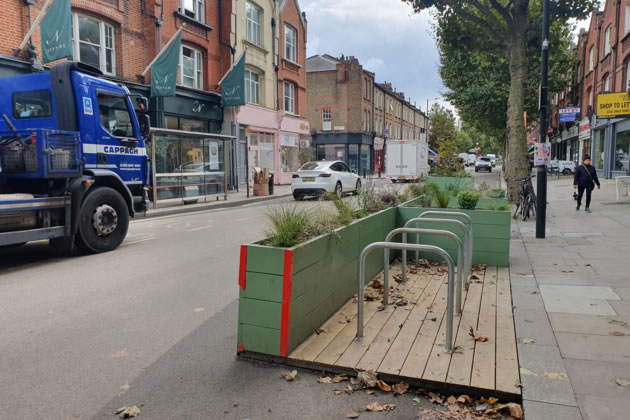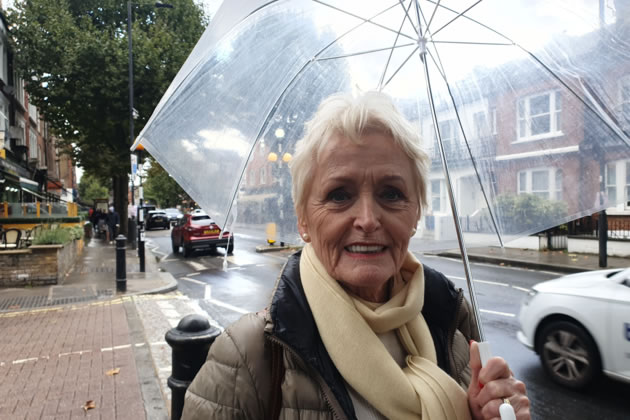Wandsworth Bridge Road Parklets Described as 'Potentially Lethal'
Supporters claim installation has had positive impact on traffic

A Wandsworth Bridge Road parklet.
October 7, 2024
Parklets installed by a Hammersmith & Fulham Council along a busy road have been slammed as ‘obscene creations’ by opposition councillors – though the scheme has also drawn praise for its impact on traffic.
Over the last couple of months, the borough has placed a series of seating and planters along Wandsworth Bridge Road, known as ‘parklets’, with more in the process of being added.
A council webpage on the works states the intention is to turn the road into a ‘destination high street’, reducing congestion and pollution and supporting local businesses.
The page cites data suggesting increased footfall as a result of making areas more pedestrian-friendly can lead to a 35-40 per cent boost to the local economy.
Not all, however, agree with the installations. There have been posts on Nextdoor expressing opposition to the scheme, while MailOnline recently spoke with several local businesses raising concerns from the aesthetics of the parklets to issues with deliveries.
The local Conservative opposition group has launched a petition calling for the removal of the parklets, which they say create an ‘obstacle course’ on the road.
Cllr Jose Afonso, the group’s environment spokesperson, told the Local Democracy Reporting Service (LDRS), “We all want to see a safe road and a thriving community – but this just isn’t how to do it. It’s a main road serving a bridge and connecting two busy parts of London, used by buses, delivery vehicles and emergency services.
“Making it into an obstacle course that forces cyclists into the path of traffic is a potentially lethal move. For people’s safety it’s time to put politics aside and remove these parklets.”
Video: LDRS/My London
The council says the interim scheme includes not just parklets, but improvements to side street junctions, pedestrian crossings and decluttering pavements.
The current measures are an experiment, which Hammersmith and Fulham will be analysing over the next 18 months prior to implementing a permanent scheme.
A spokesperson said, “These measures have safety at their heart. They will reduce congestion on the road, manage vehicle speeds more effectively and create a safer, more accessible environment while increasing opportunities for businesses.”

Proponents of the measure say they have calmed traffic speeds in the area
Leigh Durrant, 41, lives a short distance from Wandsworth Bridge Road. She described the parklets as “a waste of time and a waste of money”, adding they are ‘really dangerous’ for those using the highway.
She said, “I don’t know where they have come from. I think they are ridiculous. I don’t know who would want to sit on the road. I think it’s mad.”
Irene West, 78, was similarly unhappy with the parklets. Asked how she felt about the project, she said: “Nightmare. Absolute nightmare.”

Irene West, 78, resident by Wandsworth Bridge Road
Ms West said the South Fulham Clean Air Neighbourhoods (CANs), which are designed to prevent out-of-borough drivers rat running through side streets, have funnelled vehicles onto Wandsworth Bridge Road.
The council disputes this, and says data indicates the schemes have resulted in fewer vehicles on both side streets and the main drag.
Ms West told the LDRS, “Everything is channelled down this road and now they are putting these parklet things in. It’s just crazy. The traffic’s bad enough on this road.
“I don’t think it’s right when you pay your road tax and someone’s dictating what roads you can and can’t drive down.”
For others, the parklets presented both pros and cons. Andrew, who did not wish to give his surname, said he works along Wandsworth Bridge Road. While he initially thought they were a ‘silly idea’, he acknowledged he did see people using the ones which included seating.
Another man who lives nearby said the parklets can cause ‘chaos’, but that they do slow traffic down. This latter point was echoed by Aycine Bellaouel, 35, who cycles regularly along the road for work.
Noting that he believes cyclists are ‘struggling’ due to the space allocated to the parklets on the highway, he said the slowing down of vehicles was a positive.
“For the driver it’s better because before I remember this road. There was a lot of accidents,” he said.
During the hour or so the LDRS spent by the road, the parklets did appear to cause vehicles to slow down as they approached each installation. However, the LDRS also saw several instances of cyclists veering back into traffic due to the parklets blocking their direct route along the road.
Casey Abaraonye, from Hammersmith and Fulham Cycling, praised the council’s changes as “returning it from a highway to a high street.”
“The redesign and signing, along with the improved aspect of the traffic reductions to the neighbouring side streets are turning it into a place where people want to come and spend time, use the local facilities, and patronise the local artisan businesses.”
They added that, for locals, the stream of passing vehicles is ‘unhelpful, unwarranted, and unsafe’, and that the chicaning of the road helps slow drivers’ speeds.
“Having previously had people speed down the road at over 90mph, this is a welcome and much needed direction of development. You build for the future you want, not the present you want to leave behind. In a borough where less than a third of the youth use cars, where two in five of all residents do not own or use one, a high street for all is not relegated to the priority of a transient few who do not even stop in the borough.”
A spokesperson for Hammersmith and Fulham Council said, “We made a strong commitment to enhance and improve the Wandsworth Bridge Road during the consultations over the Clean Air Neighbourhood camera schemes to the east and west.
“Residents and businesses have told us they want a high street not a highway. These works are designed to start that journey towards returning Wandsworth Bridge Road to its former self, as a high street at the centre of the community.
“The interim scheme, which is currently being installed, features not just parklets but also improvements to side street junctions, improved pedestrian crossings, new street furniture and decluttering of the pavements.
“These measures have safety at their heart. They will reduce congestion on the road, manage vehicle speeds more effectively and create a safer, more accessible environment while increasing opportunities for businesses.”
Ben Lynch - Local Democracy Reporter